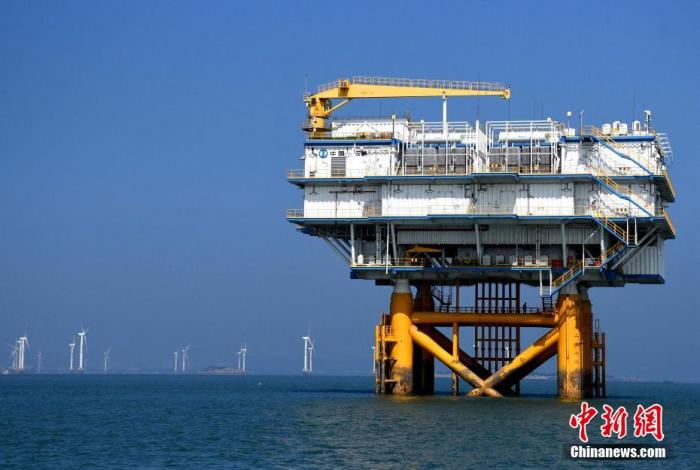(Economic Observation) The global energy revolution is intensifying, how is the layout of green energy development?
China News Service, Qingdao, October 19 (Liu Wenwen and Hu Yaojie) In recent years, major disruptive technologies in the energy sector have continued to emerge. New technologies, new business formats, and new industries have emerged in an endless stream. The energy transformation characterized by green and low carbon will lead a new round of industry. revolution.
Data map: Dalat photovoltaic base in operation.
Photo by Liu Wenhua
The second "Belt and Road" Energy Ministers' Meeting continued on the 19th.
With the theme of "Joining Hands for a Greener and Inclusive Energy Future", people from all walks of life conducted in-depth discussions on various topics such as the "Belt and Road" energy green and low-carbon development, technological innovation and cooperation to accelerate energy transformation and development.
At present, the transition to low-carbon energy under the "dual-carbon" goal has accelerated significantly. Although the world's energy consumption is still dominated by fossil energy, the growth rate of new energy consumption is rising rapidly.
In the future, energy production and consumption will show a trend of expanding from high-carbon energy to low-carbon energy, and from non-renewable energy to renewable energy.
With the further acceleration of the energy transition process, the development of green energy has become an important trend.
Zhang Jianhua, director of the National Energy Administration of China, said that China is willing to work with other countries to give full play to the role of the "Belt and Road" energy partnership platform, deepen all-round cooperation in the energy field, and contribute more to the inclusive recovery of the world economy.
China will continue to deepen cooperation with other countries in green energy strategies, plans, policies, standards, etc., carry out energy technology innovation cooperation, and strengthen capacity building and technical assistance in the field of green energy.
At the same time, provide green energy technical assistance to relevant countries as needed to provide more support for the rapid development of green energy fields in all countries.
Francisco La Carmela, Director-General of the International Renewable Energy Agency, said that despite the global economic growth slowed by the new crown pneumonia epidemic, the growth of global renewable energy installed capacity in 2020 will still exceed the expected growth, and the number of growth will hit a new high. We hope to use renewable energy to promote the global energy transition, supplemented by green hydrogen energy and sustainable biomass energy, and work hand in hand with all member states, institutions and stakeholders to move towards a carbon-neutral future.
Data Map: Xinghua Bay Offshore Wind Power Boost Station, Fuqing City, Fujian Province.
Photo by Chen Zheng
As the global energy transformation is intensifying and low-carbon and clean energy development has become a consensus, how should the development of green energy be deployed?
Xu Keqiang, Director and Deputy Party Secretary of CNOOC, put forward the concept of "green oil field", "green products" and "green industry", and pointed out that CNOOC is currently promoting green and low-carbon development and must base itself on the current low-carbon offshore oil and gas production and strive to create a "green" Oilfield"; we must focus on the production and utilization of natural gas during the transition period, and strive to create "green products"; we must look forward to the future development of the new energy industry and strive to create a "green industry".
Under the background that carbon neutrality has become the consensus and concerted action of all countries in the world, advancing the construction of the green "Belt and Road" is an inevitable choice to comply with the global energy transition and sustainable development.
Chen Xiaohua, member of the Standing Committee of the Party Committee and Deputy General Manager of Energy China Construction Group, pointed out that it is necessary to provide forward-looking, systematic, innovative and effective energy solutions based on the resources and industries of each partner country based on the latest patterns and new trends of world energy development.
Chen Xiaohua emphasized that it is necessary to strengthen the supporting and leading role of technological innovation in the development of new power systems, low-carbon development of traditional power, zero-carbon and negative development of energy and power, green development in the field of engineering construction, and sustainable development of the ecological environment, and to further promote the integration of production and technology. The integration of industry and credit will accelerate the development of digital industrialization and industrial digitization.
Under the "dual carbon" goal, building a green energy industry chain is critical to the layout of green energy.
Liu Hongbin, deputy general manager of Sinopec, proposed four measures to build a green energy industry chain. One is to vigorously promote the low-carbon transformation and upgrading of traditional oil and gas businesses.
The second is to continuously enhance the supply of green energy, and put the new energy business centered on hydrogen energy in a more prominent position.
The third is to actively deploy CCUS (Carbon Capture, Utilization and Storage) projects.
The fourth is to comprehensively plan the international layout of new energy business, and point out that we should actively respond to the "One Belt One Road" initiative, make full use of "two resources, two markets", rely on overseas oil and gas fields and refining bases, carry out wind power and photovoltaic pilot projects, and improve overseas business green Energy consumption accounts for the proportion of energy, and explore the possibility of deploying green power hydrogen production projects.
According to Sinopec's plan, a batch of world-class integrated refining and chemical bases will be built, and the average size of a single plant will reach more than 10 million tons per year by 2025.
By 2025, a total of 1,000 hydrogen refueling stations or oil-hydrogen mixing stations, 5,000 charging and swapping stations will be built, and 50 million square meters of medium and deep geothermal heating area will be added. The new energy supply capacity will strive to reach 10 million tons of standard coal.
(over)

